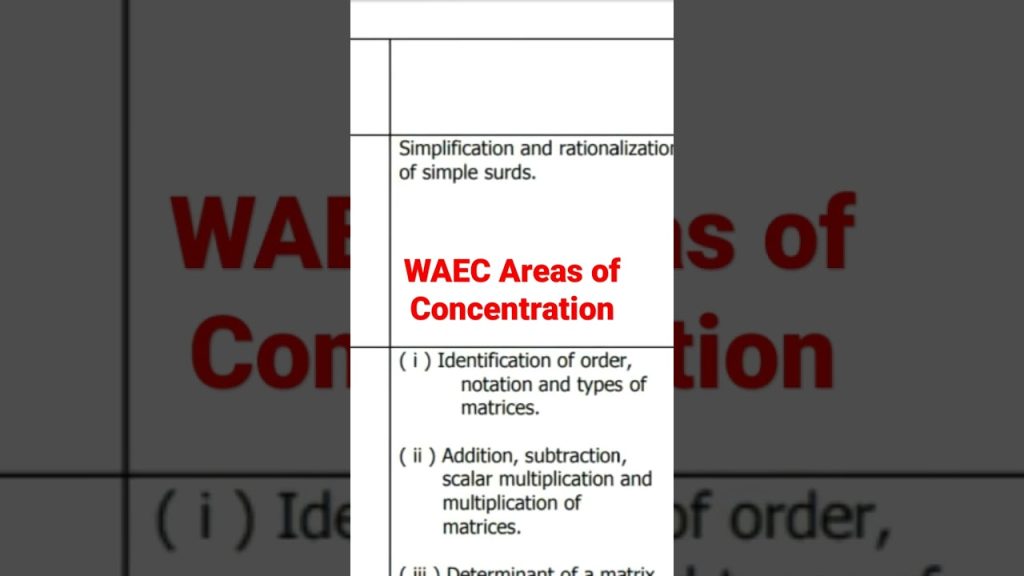WAEC Areas of Concentration for Geography 2024/2025
Are you preparing for the West African Examinations Council (WAEC) Geography exam in 2024/2025? Do you want to know the key topics, recommended textbooks, study tips, and frequently asked questions about this subject? If yes, then you are in the right place. In this blog post, I will share with you everything you need to know to pass the WAEC Geography exam and achieve your academic goals.

What is WAEC Geography?
Geography is the study of the Earth’s landscapes, environments, and the relationship between people and their surroundings. It is divided into two main branches: physical geography and human geography. Physical geography deals with the natural features and processes of the Earth, such as landforms, climate, weather, natural resources, and ecosystems. Human geography focuses on the human activities and their impact on the environment, such as population, urbanization, migration, settlement patterns, and economic development.
WAEC Geography is one of the core subjects in the WAEC curriculum. It is designed to test the candidates’ ability to:
- explain the concepts of differential character and the spatial relationships of the surface features of the Earth.
- explain the concepts of man-environment relations (i.e. to analyze the life of man within his physical and cultural environments and to explain their interactions);
- demonstrate a basic knowledge of the nature and functioning of physical and human environments, particularly an understanding of their inter-relationships and the resulting issues;
- organize and formulate principles according to acquired geographical concepts and then apply these principles to interpret and analyze spatial problems in the immediate and wider environments;
- demonstrate skills and techniques for accurate, orderly and objective geographical investigations to be carried out both in the classrooms and in the immediate environment;
- communicate geographical ideas effectively through reports, graphs, charts, sketches, diagrams and maps;
- explain the cultural, social and economic circumstances of people in their immediate environments and those of other countries within the sub-region.
WAEC Geography Exam Format
The WAEC Geography exam consists of three papers: Paper 1, Paper 2, and Paper 3. All the papers must be taken by the candidates. The exam format is as follows:
- Paper 1: This is a multiple-choice paper that contains 50 questions. The questions cover all the aspects of the syllabus. The paper lasts for one hour and carries 50 marks.
- Paper 2: This is a theory paper that contains two sections: Section A and Section B. Section A contains five compulsory short-structured questions that cover the practical and physical geography aspects of the syllabus. Section B contains four essay questions, out of which candidates are expected to answer any two. The questions cover the economic and human geography aspects of the syllabus. The paper lasts for two hours and carries 80 marks.
- Paper 3: This is a practical paper that contains two parts: Part I and Part II. Part I is a compulsory question that tests the candidates’ ability to interpret topographical maps. Part II contains four questions, out of which candidates are expected to answer any two. The questions test the candidates’ ability to carry out fieldwork and present their findings. The paper lasts for one and a half hours and carries 70 marks.
WAEC Geography Syllabus
The WAEC Geography syllabus is the official document that outlines the scope and content of the subject. It is divided into five main sections:
- Elements of Practical and Physical Geography: This section covers topics such as map reading and interpretation, weather and climate, landforms and drainage, rocks and minerals, soils and vegetation, and natural disasters.
- Economic and Human Geography: This section covers topics such as population, urbanization, migration, settlement, agriculture, industry, transportation, trade, and development.
- Aspects of Regional Geography Peculiar to Member Countries: This section covers topics such as the physical, human, and economic geography of Nigeria and other West African countries.
- ECOWAS: This section covers topics such as the history, objectives, achievements, and challenges of the Economic Community of West African States (ECOWAS).
- Fieldwork: This section covers topics such as the methods, techniques, and skills of conducting geographical investigations in the field.
The WAEC Geography syllabus is available for download in PDF format from the WAEC website or from this link
WAEC Geography Recommended Textbooks
Textbooks are essential resources for studying and revising for the WAEC Geography exam. They provide detailed explanations, examples, illustrations, and exercises on the various topics in the syllabus. Here are some of the recommended textbooks for WAEC Geography:
- Adeleke, B.O. et al (1999) Certificate Physical and Human Geography for Senior Secondary School (West African Edition), Ibadan: Rex Charles Publications
- Bradshaw, M. et al (2004) Contemporary World Regional Geography, New York: McGraw Hill
- Bunet, R.B and Okunrotifa, P.O. (1999) General Geography in Diagrams for West Africa, China: Longman
- Collins New Secondary Atlas, Macmillan
- Fellman, D. et al (2005) Introduction to Geography (Seventh Edition) New York: McGraw Hill
- Getis, A. et al (2004) Introduction to Geography (Ninth Edition) New York: McGraw Hill
- Iloeje, N. P (1999) A New Geography of West Africa, Hong Kong: Longman
- Iloeje, N.P (1982) A New Geography of Nigeria (New Education), Hong Kong: Longman
- Neba, A (1999) Modern Geography of the Republic of Cameroon, Bamenda: Neba Publishers
- Okunrotifa, P.O. and Michael S. (2000) A Regional Geography of Africa (New Edition), Essex: Longman
- Udo, R.K (1970) Geographical Regions of Nigeria, London: Longman
- Waugh, D. (1995) Geography an Integrated Approach (Second Edition), China: Nelson
- Wisner, B. et al (2004) At Risk: Natural Hazards, People’s Vulnerability and Disasters (Second Edition), London: Routledge
WAEC Geography Study Tips
Studying for the WAEC Geography exam can be challenging, but with the right strategies and techniques, you can make it easier and more effective. Here are some of the study tips that can help you prepare well for the exam:
- Start early: Don’t wait until the last minute to start studying for the exam. Give yourself enough time to cover all the topics in the syllabus and revise them thoroughly. Plan your study schedule and stick to it.
- Use the syllabus: The syllabus is your guide to what you need to know for the exam. Use it to identify the key topics, concepts, and skills that you need to master. Review the syllabus regularly and check your progress.
- Read the textbooks: Textbooks are your main source of information and explanation for the subject. Read them carefully and understand the main points, examples, and diagrams. Take notes and highlight the important facts and terms. Review the summaries and exercises at the end of each chapter.
- Practice with past questions: Past questions are a great way to test your knowledge and understanding of the subject. They also help you to familiarize yourself with the exam format, style, and difficulty. Practice with past questions regularly and check your answers with the marking scheme. Learn from your mistakes and improve your weak areas.
- Do fieldwork: Fieldwork is an essential part of geography. It helps you to observe, measure, and analyze the real-world phenomena and problems. It also helps you to develop your practical skills and techniques. Do fieldwork as often as possible and report your findings in a clear and logical manner. Use maps, graphs, charts, sketches, diagrams, and photos to support your report.
- Join a study group: Studying with others can be beneficial for your learning and motivation. You can share ideas, ask questions, explain concepts, and solve problems together. You can also test each other and give feedback. Join a study group with your classmates or friends who are also taking the WAEC Geography exam and meet regularly.
- Seek help: If you have any doubts, difficulties, or questions about the subject, don’t hesitate to seek help. You can ask your teacher, tutor, or mentor for guidance and clarification. You can also use online resources, such as websites, blogs, videos, podcasts, and forums, to find more information and tips on the subject.
Frequently Asked Questions (FAQs)
Here are some of the frequently asked questions and answers about the WAEC Geography exam:
- Q: How many papers are there in the WAEC Geography exam?
- A: There are three papers in the WAEC Geography exam: Paper 1, Paper 2, and Paper 3. All the papers must be taken by the candidates.
- Q: How long is the WAEC Geography exam?
- A: The WAEC Geography exam lasts for five hours in total. Paper 1 lasts for one hour, Paper 2 lasts for two hours, and Paper 3 lasts for one and a half hours.
- Q: How many questions are there in the WAEC Geography exam?
- A: There are 50 questions in Paper 1, nine questions in Paper 2, and five questions in Paper 3. Paper 1 is a multiple-choice paper, Paper 2 is a theory paper, and Paper 3 is a practical paper.
